Air Quality Sensor Market Research, 2034
The Global Air Quality Sensor Market was valued at $5.7 billion in 2024 and is projected to reach $12.4 billion by 2034, growing at a CAGR of 8.3% from 2025 to 2034. An air quality sensor is a device designed to detect and measure pollutants in the air, such as particulate matter (PM2.5, PM10), volatile organic compounds (VOCs), carbon dioxide (CO2), and other harmful gases. These sensors play a crucial role in monitoring both indoor and outdoor air quality, ensuring environments are safe and healthy. They are essential in various applications, including residential, commercial, industrial, and environmental monitoring, contributing significantly to public health and safety. The air quality sensor market share is influenced by the increasing awareness of air pollution's health impacts, stringent environmental regulations, and the growing demand for smart home and building automation systems. Advanced air quality sensors offer real-time data, high accuracy, and connectivity features, making them indispensable tools in the fight against air pollution
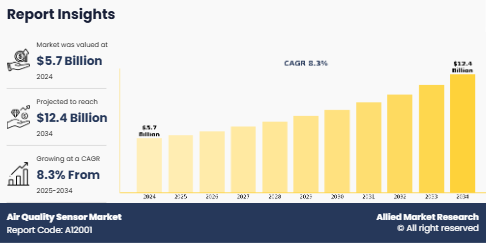
The air quality sensor market size is driven by various factors, such as rapid urbanization and industrialization, which are major contributors to air pollution and necessitate the deployment of air quality sensors for monitoring and compliance with environmental standards. Growing public awareness of the adverse health effects of poor air quality is driving demand for air quality sensors in residential, commercial, and industrial settings. Innovations in sensor technology, such as miniaturization, improved accuracy, and integration with IoT and AI, are enhancing the capabilities of air quality sensors. Additionally, stringent environmental regulations and standards are compelling industries to adopt advanced air pollution sensors.
However, the air quality sensor market outlook faces several restraints. High initial costs of installing air quality monitoring systems can deter small and medium-sized enterprises from adopting these technologies. Technical limitations in measuring certain pollutants accurately in fluctuating environmental conditions also pose significant challenges air quality sensor industry. Furthermore, variations in environmental regulations across regions can impede uniform market growth, creating complexities for global deployment.
Despite these challenges, there are significant opportunities in the air quality sensor market. The integration of IoT technology enables the interconnection of air quality sensors with other smart devices, facilitating real-time monitoring and data analysis. This connectivity transforms traditional air quality monitoring systems into dynamic, interconnected networks that can provide comprehensive and granular insights into air pollution patterns. Emerging economies, experiencing rapid urbanization and industrialization, present new investment opportunities for air quality sensors. Additionally, the development of low-cost, portable air quality sensors can cater to individual consumers and small businesses in budget-constrained markets.
Segment Overview
The air quality sensor market is segmented into Type, Industry Vertical, and Deployment.
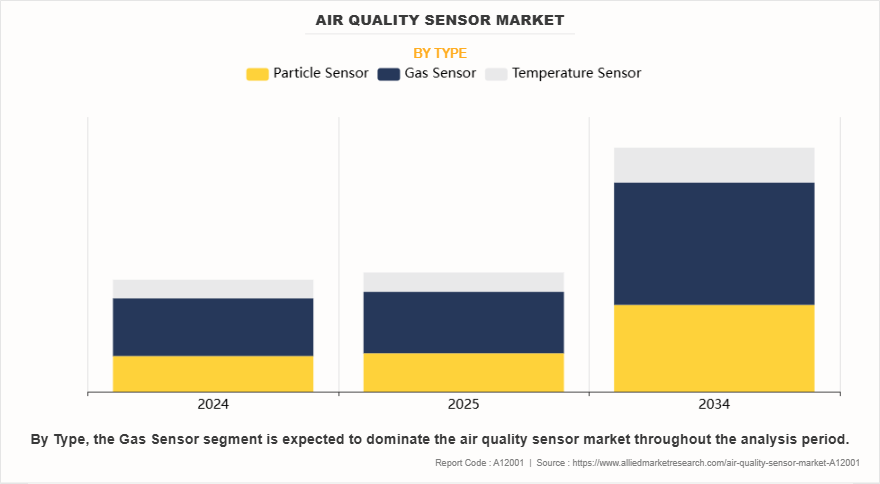
By type, the air quality sensors market share is analyzed across particle sensors, gas sensors, and temperature sensors.
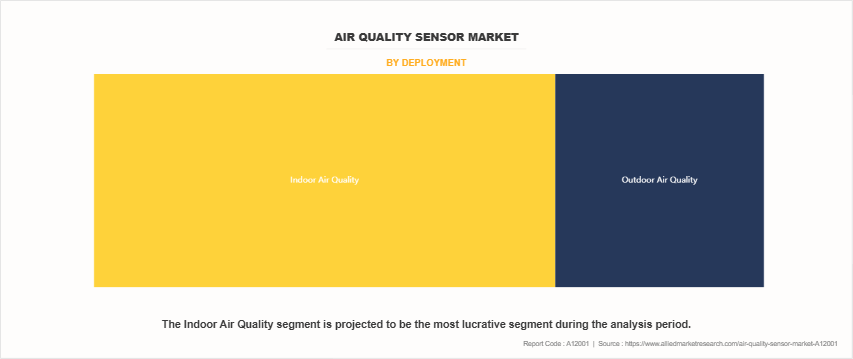
By deployment, the air quality sensor market is segmented into indoor and outdoor.
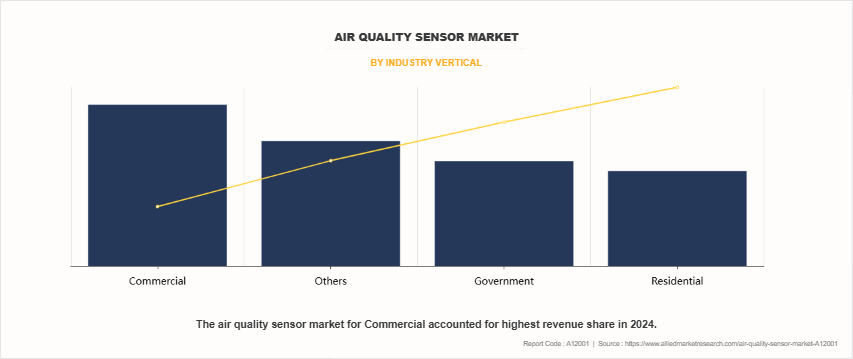
Based on industry verticals, the air quality sensors market is segmented into residential, commercial, government, and others.
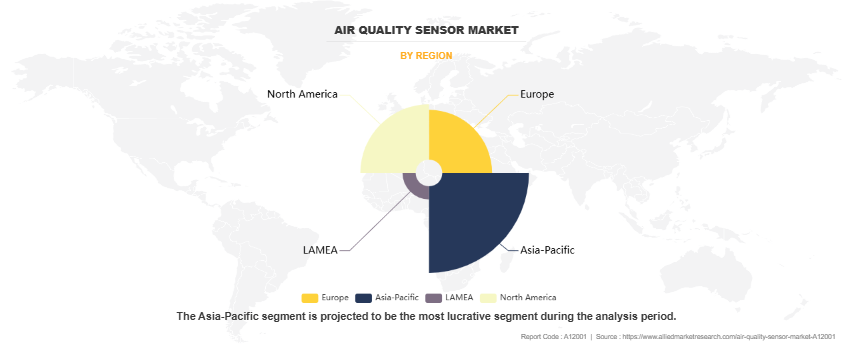
Region-wise, the air quality sensor market is segmented into North America (U.S., Canada, and Mexico), Europe (UK, Germany, France, Italy, and Rest of Europe), Asia-Pacific (China, Japan, India, South Korea, and Rest of Asia-Pacific), and LAMEA (Latin America, Middle East, and Africa). The Asia-Pacific region, specifically China, dominated the market in 2024, owing to rapid industrialization, urbanization, and increasing government initiatives to monitor and control air pollution. The growing awareness of air quality issues and the implementation of stringent environmental regulations have further propelled the demand for air quality sensors in this region.
In addition to China, countries like India and Japan are also contributing significantly to the air quality sensor market growth in Asia-Pacific. India is witnessing increased adoption of air quality sensors due to rising pollution levels in urban areas and government efforts to improve air quality monitoring infrastructure. Japan, with its advanced technological capabilities and stringent environmental policies, is also a key player in the regional market.
Competitive Analysis
The report provides competitive analysis and profiles of the leading players in the air quality sensor market opportunity, such as Honeywell Analytics, LLC, Siemens A.G., Figaro Engineering Inc, Airthings AS, Sensirion AG, eLichens, TSI Incorporated, Infineon Technologies AG, and Texas Instruments Incorporated. Additionally, it highlights the significant air quality sensor industry opportunity, focusing on emerging trends and growth potential within the industry.
Key Developments/ Strategies
- In October 2024, Figaro released a special page featuring the PDEM Series High-functionality Gas Sensor Evaluation Modules. These modules are factory pre-calibrated and suitable for evaluating various types of gas sensors, including MOS, electrochemical, catalytic, and optical sensors. They offer digital and analog outputs and are compatible with the Renesas Quick-Connect platform.
- In March 2023, Honeywell launched a solution that combines early warning smoke detection with advanced indoor air quality (IAQ) monitoring, furthering its efforts to create safer and healthier buildings. Built on the flagship VESDA-E line of aspirating smoke detectors, theVESDA Airsolution has a unique five-in-one IAQ sensor within a single box, which can help improve building safety by identifying life safety, asset protection or IAQ issues before they escalate into problems.
- In January 2024, Airthings introduced the Renew smart air purifier and the Wave Enhance IAQ monitor, designed to improve sleep quality. The Renew purifier removes up to 99.97% of fine particles, while the Wave Enhance monitor provides insights into sleep conditions and overall health. Both products are designed to enhance indoor air quality and occupant well-being.
Key Benefits For Stakeholders
- This report provides a quantitative analysis of the air quality sensor market segments, current trends, estimations, and dynamics of the air quality sensor market analysis from 2024 to 2034 to identify the prevailing air quality sensor market opportunities.
- The air quality sensor market forecast is offered along with information related to key drivers, restraints, and opportunities.
- Porter's five forces analysis highlights the potency of buyers and suppliers to enable stakeholders make profit-oriented business decisions and strengthen their supplier-buyer network.
- In-depth analysis of the air quality sensor market segmentation assists to determine the prevailing market opportunities.
- Major countries in each region are mapped according to their revenue contribution to the global air quality sensor market.
- Market player positioning facilitates benchmarking and provides a clear understanding of the present position of the market players.
- The report includes the analysis of the regional as well as global air quality sensor market trends, key players, market segments, application areas, and market growth strategies.
Air Quality Sensor Market Report Highlights
| Aspects | Details |
| Market Size By 2034 | USD 12.4 billion |
| Growth Rate | CAGR of 8.3% |
| Forecast period | 2024 - 2034 |
| Report Pages | 302 |
| By Type |
|
| By Industry Vertical |
|
| By Deployment |
|
| By Region |
|
| Key Market Players | Texas Instruments Incorporated, Airthings AS, Siemens A.G., Honeywell Analytics, LLC, TSI Incorporated, Infineon Technologies AG, eLichens, Sensirion AG, Figaro Engineering Inc. |
Analyst Review
The air quality sensors market is poised for significant growth in the coming years, driven by a combination of technological advancements, regulatory pressures, and increasing awareness of environmental and health impacts. Industry leaders express strong confidence in the market's potential, highlighting several key factors contributing to the rising demand and adoption of air quality sensors.
A major driver for the growth and need for air quality monitoring systems is the growing emphasis on environmental regulations and standards. Governments worldwide are implementing stricter air quality regulations, compelling industries to adopt advanced monitoring systems to ensure compliance. This regulatory push is powerful in regions like North America and Europe, where environmental policies are stringent.
Technological advances are also playing a crucial role. Innovations in sensor technology, including the integration of IoT and AI, have led to the development of more accurate, cost-effective, and user-friendly air quality sensors. These advancements have made it easier for both businesses and consumers to monitor air quality in real-time, driving widespread adoption.
Emerging markets, especially in Asia-Pacific, are expected to see substantial growth. Countries like India and China are investing heavily in air quality monitoring infrastructure due to rising pollution levels and increasing public awareness. These investments are creating significant opportunities for market expansion in these regions.
Asia-Pacific is currently the largest regional market for air quality sensors, with significant investments in air quality monitoring infrastructure
Integration of IoT technology, AI, and real-time monitoring capabilities are key upcoming trends in the global air quality sensor market
The air quality sensor market was valued at $5,705.4 million in 2024 and is estimated to reach $12,444.8 million by 2034.
The leading application of air quality sensors is in commercial segment, including both indoor and outdoor air quality assessment
Top companies holding market share in air quality sensors include Honeywell Analytics, LLC, Siemens A.G., Figaro Engineering Inc, Airthings AS, and Sensirion AG.
Loading Table Of Content...
Loading Research Methodology...



